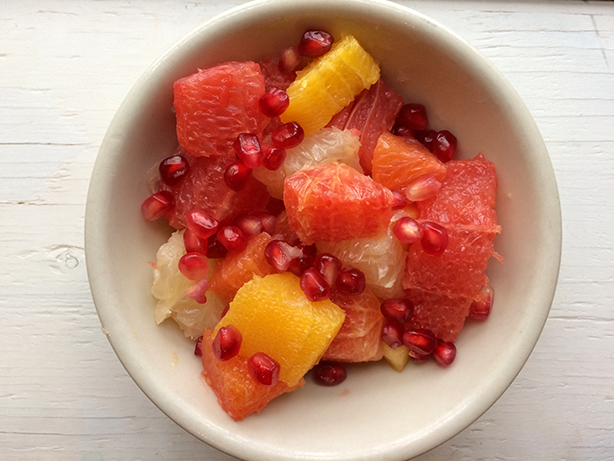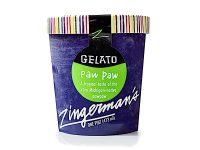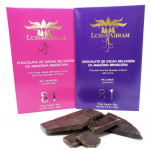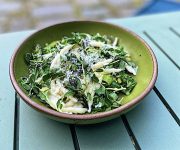Get It While You Can: The Deli’s Citrus Salad Is in Season

Citrus’ wild origins can be traced to Southeast Asia. Unlike our contemporary sweet varieties, early species of citrus fruit were extremely bitter. Anthropologists believe that they were used not for food but rather as medicine, cleansers, embalming fluid and beauty treatments. The first edible citrus probably resulted from crossing citron—a large, bitter fruit with lots of rind and little flesh—with sour oranges. This fruit first appeared in the Hellenic world around 500 BCE and was used as an antidote for various poisons.
One of the more interesting characteristics of citrus fruit is that they are prone to mutating and crossbreeding spontaneously. Whenever the pollen of one variety pollinates the flowers of another species of citrus there is a chance that they will create a hybrid offspring. Sweet oranges are thought to have appeared as a result of this spontaneous interbreeding, crossing a tangerine with a pomelo (Citrus Grandis), which is believed to be an ancestor of modern grapefruit. They arrived in the Mediterranean in the 13th century CE and were brought to the western hemisphere as one of the initial acts of the Columbian Exchange.
Our Citrus Fruit Salad features three kinds of oranges (Washington navel, Cara Cara, and Blood) as well as white and ruby red grapefruit. Washington navels, commonly referred to as, simply, navels, are identified by a small orange bulge (resembling a belly button) found on the blossom end of each fruit. This bulge is actually an undeveloped second orange and is the result of a spontaneous mutation discovered initially by a Brazilian orange farmer in the early to mid-1800s. This slight change resulted in an orange that was seedless, as well as sweeter and easier to peel than its conventional parent. This unique breed so fascinated the U.S. commissioner of agriculture that he, in 1871, imported saplings to be grown in Florida. Unfortunately, due to the hot, humid climate, the trees never bore fruit and most of them died.
Three surviving trees were transplanted to cooler, drier Riverside, California where they thrived under the care of the Commissioner’s friend, Eliza Tibbets. Once the trees started to produce their distinct fruit, local nursery owners quickly realized their superiority and began to graft them and create clones. Navels are now the most common variety of orange in the U.S. and can all be traced back to Mrs. Tibbets’ trees, one of which still stands in Riverside.
Navels
Our navels are coming from Chaffin Family Orchards located in the northeast side of the Sacramento Valley in northern California. Chaffin is a permaculture-based operation that triples as an olive grove, an orchard and a pastured livestock ranch. Unlike most industrial orchards which harvest their crops all at once, Chaffin picks its fruit individually, only at the peak of ripeness, ensuring that each orange is at its prime sweetness. Chaffin’s growing practices are all natural and toxin free, the fruit having never been sprayed, chemically fertilized, gas ripened or refrigerated. All fruit is packed and shipped the same day it is picked. This year’s cool, rainy weather in California has made these already delicious oranges even better. In addition to adding these to our daily fruit salad we are selling them individually in the Next Door and in the 420 building. For $1.00 apiece, they are quite the steal.
Cara Cara
Cara Cara oranges were created by another spontaneous mutation, this time of the Washington navel itself. Like the navel, Cara Caras feature a similar bulge on its blossom end resulting from an undeveloped second orange. Besides the latter being slightly smaller in size, the main difference between the two is uncovered beneath the rind; Cara Caras have a rose hued flesh, due to high lycopene contents, and are sweeter and less acidic.
Blood Oranges
Blood oranges are the smallest of our three varieties. When ripe they produce a purplish skin and a fruit that ranges from a pinkish orange to a dark blood red, hence its name. While all oranges pack a nutritious punch, the blood orange is perhaps the healthiest. Similar to purple carrots, it is chock full of anthocyanins, which are robust antioxidants and responsible for its dark color. Though they are gaining in popularity in the States, blood oranges enjoy more prominence across the Atlantic where they are a favorite throughout the Mediterranean and are often the variety of choice for Italian orange juice.
Pink Grapefruit
Until 1905 all grapefruit had white flesh. That year a Florida farmer witnessed abnormal looking grapefruits on one of his trees. When he cut into it he discovered that it had pink flesh, and, upon eating, a sweeter taste, thus discovering the first pink grapefruit. A quarter of a century later another darker and sweeter version popped up in Texas. This one, named the Hudson Pink, was another product of, you guessed it, spontaneous mutation. Not wanting to rely on chance any longer, scientists at the Texas A&M University Citrus Center sent seeds to the Brookhaven National Laboratory to be irradiated and mutated. One of these seeds resulted in the creation of the Star Ruby variety, which was then irradiated again, four years later, to produce the Rio Red. All three varieties: Hudson Pink, Star Ruby and and Rio Red, monopolize the U.S. grapefruit market. Though we think of modern fruit and vegetable breeding as a boon to production and yields, and a detriment to nutrition, this is not so with the red grapefruit, which have the highest density of anthocyanins and other phytonutrients than any of the paler varieties.
We’ll be featuring Citrus Fruit Salad while oranges and grapefruit are at the height of their season so get it while they are at their best!




Zingerman’s Art for Sale